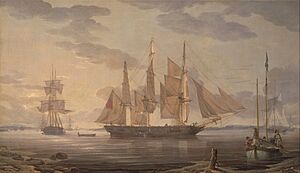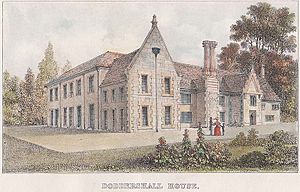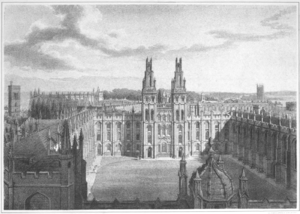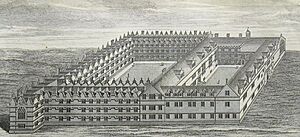John Lloyd (judge) facts for kids
John Lloyd (1533-1607) was an important Welsh lawyer and judge. He worked in London as a judge for the High Court of Admiralty, which handled legal issues about ships and the sea. He was also a member of All Souls College at the University of Oxford. John Lloyd even helped Queen Elizabeth I start the very first Protestant college at Oxford University, called Jesus College.
Contents
Who was John Lloyd?
John Lloyd was born in 1533 in Wales. He was the third son of David Lloyd. John lived in a place called Hartshorne and also had a home in London. He married Elizabeth Pigott, whose father was a important official in Buckinghamshire. His family had many connections to other powerful people.
John Lloyd studied at the University of Oxford. He earned his first degree in 1542. He became a Fellow at All Souls College, which meant he was a senior member of the university's governing body. He continued his studies, earning degrees in civil law in 1554 and 1565.
In 1566, he became a lawyer in the Canterbury Court of the Arches. Later, he became a judge for the High Court of Admiralty in London. This court dealt with all sorts of sea-related legal matters. He worked under important leaders like the Lord Admiral, Edward Clinton, and Charles Howard, who was a cousin of Queen Elizabeth I.
What did an Admiralty Judge do?
As a judge for the High Court of Admiralty, John Lloyd handled many different maritime issues. This included problems like piracy (sea robbery) and the capture of warships or trading ships by enemies. He also helped settle disagreements between merchants, sailors, and ship owners.
The Admiralty Court was very important for traders. It helped protect their rights and solve problems they had with pirates. John Lloyd worked during the Tudor period, a time of big changes for Britain. This period marked the beginning of the British Empire.
Britain started to expand its trade and influence around the world. This happened because of better ship technology and new ways to fund voyages. King Henry VIII and later Queen Elizabeth I made reforms that helped the Admiralty Court grow. It could now handle more complex legal and financial issues. These included trade disagreements, shipping costs, insurance, and ship loans. This growth created opportunities for ambitious lawyers like John Lloyd, as more judges were needed to handle the increasing amount of maritime trade.
John Lloyd's later life and contributions
In 1559, John Lloyd was briefly appointed as a church leader in Wales, but he left that role later the same year. A very important event in his life happened in 1571. Queen Elizabeth I named him as one of the eight founding members of Jesus College, Oxford. This college was special because it was the first Protestant college at the University of Oxford. It was also the only college Queen Elizabeth I created there.
Other important people who helped found Jesus College with John Lloyd included:
- William Cecil, the Queen's Secretary of State.
- Sir Christopher Hatton, the Lord Chancellor of England.
- Nicholas Bacon, who held the Great Seal of England.
There were 8 founding members, 8 founding commissioners, and 8 founding scholars for the college, along with a Principal. In 1589, Queen Elizabeth I changed the college's rules. She reduced the number of members from 22 to 13 and made them all "Commissioners." John Lloyd was one of these 13 founding Commissioners, showing his continued importance to the college. Before Jesus College was founded, John Lloyd had also been the head of another hall at Oxford University called White Hall.
John Lloyd passed away in February 1607. He was buried in the Minster church at Chester Cathedral in England.
John Lloyd's family connections
John Lloyd was part of the Griffith family, a powerful family from Wales. They became very influential in their region.
His family included several notable people:
- John Griffith, who was in charge of Carnarvon Castle and a naval officer for North Wales.
- Sir John Griffith, a close friend of the Earl of Nottingham, who was also a cousin of Queen Elizabeth I.
- Edmund Griffith, who became a Bishop of Bangor (a church leader).
- Sir Richard Bulkeley, whose family was connected to important noble families.
- Lancelot Bulkeley, who became the Archbishop of Dublin and a member of the King's advisory council in Ireland.
- Richard Bulkeley (died 1621), who was in charge of Beaumaris Castle.
John Lloyd's children
John Lloyd had children who also made important family connections:
- Frances Lloyd married Dr. David Yale.
- Their son, Thomas Yale (1587–1619), later became the grandfather of Elihu Yale. Elihu Yale is famous for being the person after whom Yale University in the United States is named. After Thomas Yale died, his wife, Ann Lloyd, married Governor Theophilus Eaton.
- Mary Lloyd married Sir Simon Weston.
- Their only daughter, Elizabeth, married Robert Ridgeway, who became the 2nd Earl of Londonderry.






